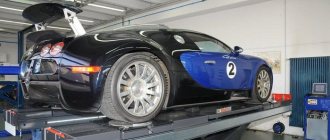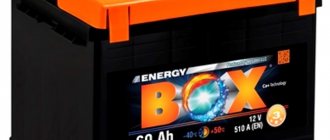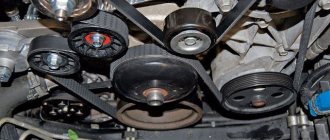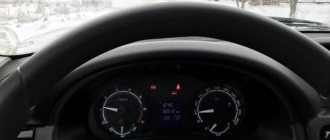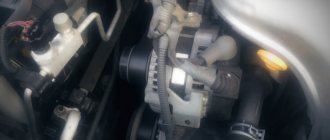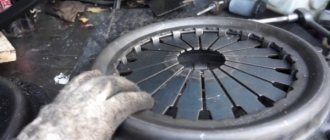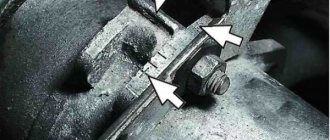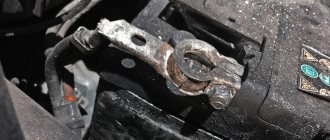General features of the problem
The whole insidiousness of the situation lies in the fact that vibration of the steering wheel when driving is, if not the most common, then quite an annoying problem. It usually creeps up unnoticed when you don’t pay attention to it at first, but at one fine moment the beating can already be felt throughout the whole car. And at this moment we understand that we have gradually become accustomed to this obsessive defect and therefore are in no hurry to eliminate this problem. And in vain.
In the long term, vibration can result in significant repair costs. Therefore, it is in the interests of the owner himself to determine the source and causes of the malfunction. To get started, just perform a number of simple operations:
- drive a car along the highway and feel the level of beats at various speeds;
- notice at what speed the vibration effect begins and at what speed it disappears;
- check for shaking of the steering wheel when the car is stationary and the engine is idling;
- test the behavior of the car when accelerating and when pressing the brakes.
Sometimes the essence of the breakdown lies in trivial damage to the tires , so we check them first. Steering wheel vibration during braking and the reasons for its occurrence require special attention, because this is direct evidence of a problem in the braking system. In general, the classification of cases of steering wheel beating is as follows:
- Steering wheel oscillations on the riser at idle speed of the internal combustion engine.
- Steering column runout when driving a car at various speeds.
- Steering wheel pulsates when pressing the brake pedal.
- Vibration of the steering wheel when making turns.
In order to avoid troubles in the future, we will consider the most common types of beats, as well as the causes and methods of eliminating the problem.
Painfully banal
If the body vibrates when accelerating, you should not be upset and immediately count out a large amount for repairs. Below are some common and not so common cases that can cause discomfort when driving:
- Dirt or ice block stuck to the inner rim of the wheel rim. Diagnosing the adhesion of dirt is not difficult, since noticeable beating will occur only after off-road driving. In winter, every driver should be prepared for such troubles;
- Incorrect installation of brake and wheel discs. If the mating plane has not been cleared of contaminants or is deformed, this will cause an increase in vibration load during movement;
- discrepancy between the landing dimensions of the wheel rims. Each disk has its own installation parameters, violation of which can lead to imbalance. This mainly concerns disc bolt patterns;
- loose disk fastenings. This is the first thing to check when you notice runout in the steering wheel. The consequences of neglecting this advice can be very dire.
Many car enthusiasts are familiar with the problem when vibration occurs when accelerating. There are many reasons for this phenomenon. Often, searching for a source can even drive a car enthusiast crazy. Let's look at the main reasons for shaking, because you really want the car to drive quietly and smoothly. In 75% of cases, the problem is detected and fixed, and the car owner can again feel calm and comfortable.
The effect of vibration of a car steering wheel when driving at certain speed levels
This type of runout can occur both at speeds above 100 km/h and at low speeds. You should immediately note the root cause why this happens - it is ordinary dirt or snow that gets into the disc cavity. This phenomenon causes an uneven distribution of the mass of the rotating wheel, which causes runout.
Once a wheel hits a pothole, there is also the possibility of an imbalance in its weight distribution. Otherwise, the culprits of steering column vibrations are worn out elements of the front suspension. In any case, if vibrations in the steering column occur while driving, the driver urgently needs to check the following components of the car:
- Wheel balancing . Typically, beating due to uneven mass distribution appears at speeds between 60 and 100 km/h. It can be eliminated without any special material costs at a regular tire shop.
- Shock absorbers and struts . Wear of these parts causes uneven operation of the suspension, which causes vibration in the car's steering wheel when driving on uneven surfaces at speeds over 80 km/h. The issue is resolved by replacing faulty elements.
- Support bearings for struts . If worn, they cause vibration phenomena at speeds above 80 km/h and urgently need to be replaced.
- Ball joints . These units often have play due to poor road surfaces, which causes the car to shake. This is especially felt on the steering wheel when the speedometer needle approaches 100 km/h.
- Tie rod ends . Operational wear causes play at key points, after which the parallelism of the front wheels is disrupted. A vibration effect on the steering wheel is felt at speeds of 90 km/h and above.
- Silent blocks . Wear and damage to the integrity of this part causes beating when reaching 100 km/h.
Important! Do not think that if the steering wheel is pulsating, then it is enough to balance only the front wheels. You should always perform weight balancing on all four wheel rims. Pay attention to the presence of deformations on the discs.
Balancing required
Runout on the steering wheel and car body with increasing speed is inevitable if the wheels are not balanced. The uneven distribution of mass relative to the center of the wheel rim leads to such consequences. The action of multidirectional centrifugal forces leads to the appearance of multi-frequency oscillations, which are felt as a beating in the car interior.
The problem may manifest itself in the following cases:
- Installing new tires. Replacing tires on rims or putting new rims on old tires must be accompanied by balancing. Even for the manufacturer, achieving ideal weight distribution and geometric parameters seems to be an extremely difficult task.
- Loss of old balancing weights. This is especially true for light alloy wheels, where the weights are glued to the inside of the wheel. Let us remember that in the case of stamped rims, the weights are placed in the outer shoulder of the rim.
- Deformation of the rubber or disk due to falling into a deep pothole, a strong impact with the curb and other similar obstacles.
- Natural imbalance. During operation, any wheel will lose its established balance. It is recommended to carry out scheduled balancing every 15-20 thousand km.
Another breeding ground for imbalance is often the constant velocity joint. It serves as a device for the movable articulation of the drive shaft and gearbox, which allows the transmission of torque in different planes (internal CV joint). At the other end of the drive shaft for articulation with the hub (outer CV joint).
Most often, the cause of vibrations lies precisely in the internal hinge. In the case of a tripod-type design, wear out of the rollers is observed. In especially severe cases, the bearing may even “fall apart”. It is also possible to produce a tripod glass.
A similar malfunction can be caused by a torn boot, which can no longer protect against dirt and dust flying from under the wheels. Therefore, periodically check the integrity of the CV joint boots.
Drive shaft
It will be worth mentioning that a car with a drive of irregular geometric shape is guaranteed to experience vibration when accelerating. A bent drive shaft will not only rotate around its axis, but also provoke parasitic centrifugal forces. As a result, the car will receive additional vibrations as it accelerates.
Cardan
The problem is typical for cars with rear-wheel drive and all-wheel drive. Wear of the cardan joint leads to vibration during acceleration. If you encounter a similar problem, pay attention to the following elements:
- crosses;
- suspension bearing;
- directly to the driveshaft. An unbalanced cardan will lead not only to beating, but also to subsequent destruction of the joints.
Where does the car steering wheel vibrate when braking and the reasons for this effect?
The steering wheel wobbles when you press the gas pedal is also quite common. The main culprits here are the following factors:
- Uneven wear and deformation of brake drums or discs.
- Poor condition of the brake pads.
- Play in ball joints.
- Uneven force or jamming of brake calipers.
In any case, to determine the true cause of vibration of the car steering wheel when braking, you need high-quality diagnostics. If the source of vibration phenomena is the brake disc, then it needs either re-grooving or replacement. A disk that is too thin also requires replacement.
Installing a new disc involves performing certain technological operations, deviation from which causes the steering wheel to wobble. For example, when replacing, mechanics often do not screw the mounting bolts into the hub. But it is precisely these seemingly insignificant details that are responsible for the reliable fixation of the disk.
Practice shows that the performance characteristics of pads and brake discs are negatively affected by sudden cooling. A striking example is a car wash, when cold water is poured onto discs that have not had time to cool down. After such “water procedures” the disc may lose its geometry, as a result of which the steering column begins to vibrate.
Let's sum it up
So, common causes include wheel mounts, loose brake discs, a deformed drive shaft, constant velocity joints, and wheel bearings.
Vibration occurs when accelerating from anything. There are a lot of reasons. But if you try, you can detect them yourself and not pay for diagnostic services at a service station. But if suddenly you can’t figure it out on your own, don’t put off the decision. This leads to bad consequences. With simple steps, you will definitely find the causes of vibrations in your car and eliminate them. Take malfunctions seriously, because a neglected problem can cause an accident.
A few more options
Vibration of the steering wheel at idle is quite common. This factor is easily determined - pulsations on the steering wheel depend entirely on the number of revolutions. The following elements may be the cause:
- Destroyed engine mounts.
- Drive shaft deformation.
- Unstable operation of the internal combustion engine.
- Transmission malfunctions.
In case of interruptions in engine operation, you should first check the spark plugs and, if necessary, replace them. Owners of cars with air conditioning should be aware that the root cause of steering wheel vibration at idle and when driving may be an imbalance or breakdown of this air conditioning unit.
It is important to understand that any vibration processes are the result of any malfunctions in the car components. Therefore, there is no need to delay the diagnosis and subsequent repair of the car, because any delay can result not only in significant expenses, but also threatens the safety of all road users.
We explore the engine compartment and engine sounds
If you determine that the vibration is coming from under the hood, most likely the cause will be improper operation of the engine or the mounting points of vibration-loaded elements.
Problems related to internal combustion engines:
- Engine tripping. Many car owners have encountered a situation where, when accelerating or driving under tension, the engine begins to shake, and the thrust is much weaker than before. In this case, comprehensive engine diagnostics is necessary. The problem may be hidden in the ignition system: worn-out spark plugs, GDP, module and other elements, the malfunction of which leads to misfire in one or several cylinders at once. Possible burnout of valves, insufficient fuel pressure, etc. There are so many reasons that the topic deserves separate detailed consideration.
- Engine support cushions. Vibration during acceleration will appear because an increase in engine speed increases the centrifugal forces acting on the car body. When you sharply press the accelerator pedal to the floor, noticeable shocks may be observed. Made of hard rubber, even new cushions will cause vibrations.
Gearbox and clutch drive
It is also worth paying attention to the mounting locations of the gearbox. Perhaps the reason may be hidden inside the gearbox housing. In the case of a manual transmission, for a more accurate diagnosis, you should pay attention to the factors causing vibration or beating. If symptoms only appear at a certain speed limit, try driving it alternately in different gears. For example, if vibration is noticeable at 70 km, first engage 2nd gear, then 3rd (of course, if the gearbox ratios allow). This way, you can more accurately identify the transmission components that cause vibration.
If there is deformation of the input shaft in the gearbox, vibrations will be noticeable when accelerating in any gear.
An unbalanced flywheel can also cause the symptoms discussed. At the same time, it is worth paying attention to the clutch and release bearing.
If the car has an automatic transmission, check the oil level and condition. An indicator that is too low can cause shocks and vibrations.
Exhaust system
Improper mounting of the engine exhaust system can lead to noticeable vibrations in certain engine operating ranges.
How to identify the source of vibration
Determining the source of vibration is a very difficult issue. To begin with, a car enthusiast must understand when vibration occurs - in a moving or stationary car.
In addition, it is necessary to analyze when the vibration appeared. Perhaps repair work was only recently carried out at a service station, or this phenomenon was noticeable from the very first days of purchasing the car.
The first thing you should pay attention to is engine performance. Vibration in the cabin is often felt precisely because of incorrect settings of the “heart” of the car.
To analyze this moment, it is necessary to observe the operation of the engine at idle - how “smoothly” it runs, whether there are periodic “fall asleep” and “bursts”.
To make the check more effective, you can call a friend to help you. In this case, one will observe the vibration in the cabin, and the second will carefully inspect the engine compartment.
Engine mounts, tie rods and other problems
There is another group of problems that cause vibrations when accelerating a car. It is difficult to collect these problems into one bundle, because they are all different and arise for various reasons. Vibration often occurs when one of the engine mounts is broken. This can easily be checked by increasing the speed while shaking.
The gearbox may also be the culprit for this type of problem. If the car starts to shake at 80 kilometers per hour, you can very easily check the fault of the gearbox by performing the following procedures:
- accelerate to a speed of about 85 kilometers per hour;
- depress the clutch and observe the vibration change;
- engage third gear and smoothly release the clutch;
- try accelerating from 50-55 kilometers per hour in last gear.
If the nature of the shaking does not change in all these experiments, the box has nothing to do with this problem. If there is more shaking when the gearbox is engaged, you will have to check whether it is involved in this problem.
You can also check the automatic transmission. At a speed of about 85-90 kilometers per hour, it is enough to switch the gearbox selector to modes 3, 2, D, N and observe the operation of the box itself and the change in vibrations. Often the gearbox is not to blame for the vibration of the car body, but there are such cases.
For useful tips on some possible causes of shaking, watch the video:
Vibration at speed
p, blockquote 21,0,0,0,0 –>
It is not always possible to find out the cause of car vibration using computer diagnostics. There are generally accepted recommendations from experienced drivers, mechanics, suspension, steering, and gearbox specialists that help find the causes of vibration at different speeds and with different signs of their manifestation.
p, blockquote 22,0,0,0,0 –>
Table 1. Symptoms of malfunction and possible causes of vehicle vibration when driving at various speeds:
p, blockquote 23,0,0,0,0 –>
| Speed | Symptoms of malfunction, possible causes |
0 km/h (idle speed)
Vibration of the gearshift lever - misfire, engine tripping. Metallic uniform knocking - damage to the engine mount. High-frequency whistle - wear of the alternator belt.
Uniform slight shaking - unbalance of the flywheel or clutch.
Uneven slight shaking - misfire, malfunction of the fuel supply system, air supply, or engine management system.
0 km/h (high speed)
adsp-pro-2 –>
Video - if the car shakes during acceleration, then a possible reason could be a grenade:
p, blockquote 24,0,0,0,0 –>
”
p, blockquote 25,0,0,1,0 –>
Wheel alignment and tire quality are another reason for shaking
If the wheel alignment angle is incorrect, vibration, the car pulling to the side, uneven eating of rubber and other unpleasant manifestations are possible. In different models, these problems manifest themselves in different aspects. Adjusting the wheel alignment angles is one of the first processes that needs to be performed after detecting such a nuisance as body vibration.
Problems can also be caused by tires that are worn incorrectly, or a disc after a serious impact. The main processes that can be taken to eliminate body vibration in this case are as follows:
- adjusting the wheel alignment angle at a wheel alignment station;
- replacing tires if there are visual indicators of uneven or excessive wear;
- replacing or repairing a disc that shows dents and uneven rims;
- performing wheel balancing - often during operation the balancing weights fly off.
If the balancing weights have come off the wheel, this may well cause vibrations at speeds of 80 kilometers per hour. The problem is that it is simply impossible to determine this yourself and find out which wheel needs to be sent for balancing. Therefore, you will have to go to a tire shop and have all the wheels of your car balanced.
This is one of the most inexpensive and safest options for breakdowns due to vibration of the body or steering wheel during acceleration. Therefore, the first thing you need to do is check for the presence of such faults, and then transfer suspicions to other options.
